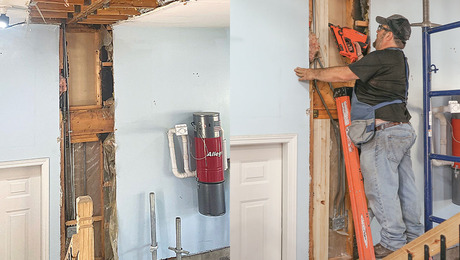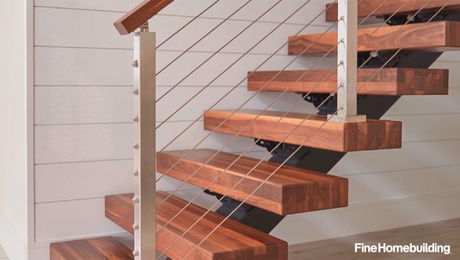I recently moved into a new house and am beginning the process of changing the basement over to a Wood/Metal Shop. I have been trying to do my homework on finishing/insulating this space correctly, so I do it once and be done. Looking for some advice/feedback on my plan. I will be renovating this space in sections starting with the areas that are unfinished, but I want to do each area correctly so when I finally get all the way around, I am solid. Any advice would be appreciated as there are so many methods/opinions out there I have about overwhelmed myself with information at this point.
The current situation is this. The basement is partially finished and appears from what I can see, that the previous person used a plastic sheet up against the wall behind metal studs filled with fiberglass insulation and covered with drywall. I do not currently perceive any problems. The basement is dry and no mold or mildew smell. I believe portion that is finished was done back in the late 90’s/early 2000’s. About 50% of the basement is finished walls and the other half is bare cinder blocks. The front of the house (currently the finished side) is under ground and the rear is ground level (unfinished) with a walk out exterior door. The sides are mostly underground, and one is finished. The other side is not. I am in Maryland which I believe is Zone 2 temperature wise.
My plan is to adhere either 1-inch R-Tech or Owens foam panels directly to the walls and seal them with tape. Then frame a wall in front of the foam panels and fill the cavities with Rock Wool. Then there will be either drywall (mold resistant) or plywood over top depending on the location. I will also be stuffing rock wool up into the rim joist. I plan on putting Safe and Sound in the ceiling to dampen the noise between floors but that too will be done section by section. This will eventually be one large open area with as few interior walls as possible.
Here is what I am hoping for some feedback on:
#1 – Is my plan solid and good?
#2 – Do I really need to use the metals studs. They are $13-$18 each locally vs $3.35 for wood. I know the metal is better but, in my head, if I ever have a flood the drywall all has to come down anyway, so I am not positive it is worth such a big price difference.
#3 – If I do use wooden studs is there something that should go under those to prevent moisture from wicking up from the slab? If so what is that? I was thinking roofing felt.
#4 – Are the R-Tech panels Home Depot sells good enough as they are significantly less expensive than the Owens pink ones. I am more after moisture/rot/bug protection than insulation value since that will mostly come from the Rock Wool. Temperatures in the basement are just fine now with no heat and it was 14 degrees outside for a couple of days last week.
#5 – Am I correct in assuming that I do not need an additional vapor barrier between the rock wool and the drywall since the foam will be installed directly onto the concrete?
#6 – Anything I am missing?
Thanks much – any feedback would be appreciated.















Replies
I think you have the zone wrong.
https://basc.pnnl.gov/images/iecc-climate-zone-map
Several MD counties have guides for basement finishing. for example: https://www.carrollcountymd.gov/media/12235/finished-basement-modified-1-3-20.pdf
In a similar zone, Fairfax county, va has a guide with a bit more info you may want to read
https://www.fairfaxcounty.gov/landdevelopment/sites/landdevelopment/files/assets/documents/pdf/publications/basement-details.pdf
Metal studs are straight. Wood ones can vary. (and warp in mysterious ways)
If you install a wood stud wall in the basement, the bottom plate should be treated.
There are differences between EPS and XPS. check the specs, including R values.
It is important not to have a vapor barrier sandwich. so no interior vapor barrier where there is foam or plastic on the outside of the finish wall assembly.
for your outside wall, (behind the house) You have a couple choices. You could put in stud wall, insulate and install an interior vapor control barrier, and call it a day.
You also could use a continuous foam board solution for the insulation. 2 inches of XPS would give you R10 continuous. You could fasten strapping through the foam into the block wall, then hang drywall. Or build a stud wall inside and hang drywall.
One thing to be aware of with foam, then insulation inside, is that under some conditions, you can have the inside temperature of the foam low enough to have water condense. Plastic sheet would be worse in this case, but at the front of your house, buried, it is less likely to give you issues than, say, application in a roof assembly.
You can run numbers using outside conditions, and inside temp and humidity, then calculate temperature drop over the differing R values. More likely to have issues if you will use this shop space for moisture-laden activities.
For the rim joist, I would be wary of stuffing rock wool and calling it a day. the issue is air movement, and with a lot of it, you can get condensation inside the insulation.
I redid my basement a few years ago (at peak covid), and used a pro foam gun to seal XPS along the rim joist. I followed up by turning on exhaust fans and the dryer on a cold day, to identify and remedy sealing failures.
For sound isolation, you also can look into additional methods to go with your safe and sound. https://soundproofcentral.com/soundproof-ceiling/
I had a few comments, and the web site sent them to never-never land
so I will drop a few in individual comments.
First of all, steel studs are straight. wood not so much.
If you put a wood stud wall in the basement, the bottom plate should be treated.
a few MD counties have guides for basement remodel, you likely will want to be informed.
I live across the river and Fairfax county VA has a guide you might want to read.
https://www.fairfaxcounty.gov/landdevelopment/sites/landdevelopment/files/assets/documents/pdf/publications/basement-details.pdf
It is important not to have a vapor control sandwich, so anywhere you have plastic or foam board along the block wall, the inside of your finish wall should be treated to allow vapor to escape. no vapor barrier. You could consider one of the semi-permeable films that vary with conditions.
For the wall that is open on the other side, you can treat it as any other exterior wall.
You could put 2 inches of XPS (learn the differences between EPS and XPS) as a continuous layer and either hang drywall from furring strips you secure through the foam to the block wall, or from a stud wall you build inside.
You could also build the stud wall, insulate, and apply vapor control under the drywall (or use drywall primer formulated to be a vapor control layer)
I would be careful jamming rock wool into the rim joist cavity and calling it a day.
there is likely a lot of air leakage, and moving air inside insulation will likely at some times have moisture condense out inside the insulation. the air flowing on its own is a watt waster, stealing your hard-earned heating and cooling dollars.
I redid my basement a couple years ago, and sealed the rim joist with XPS foam, using a pro foam gun to seal in place.
I followed up with a check and repair cycle, turning on the bathroom exhaust fans, kitchen hood fan and dryer, on a cold day, and checking for leaks with an IR thermometer and my finger. Ended up pretty tight and cozy.
You may want to consider how to seal all the cracks along the rim joist before insulating.
And the last thought is that as you consider sound isolation, there are additional methods to help a layer of safe and sound.
Isolation and mass are your friend.
Some discussion I googled up for you.
https://soundproofcentral.com/soundproof-ceiling/
OK one more thing.
when considering a layer of foam board with additional fiber insulation, you may want to think about conditions. your basement is not going to be the most challenging, but with only an inch of foam you might want to think about it.
In some conditions, the sandwich will result in temperatures at the interior of the foam below the dew point. You can look at outside temperature, and estimate inside conditions, and see what an R value sandwich would do.
I do not think in MD in the basement, this will be a huge issue, and if it was, that wall with plastic along the block would be the first to see issues. but it is on the wall that is buried, so likely have a moderated temperature.
Where are you in MD, anyway. there is a bit of a difference between the DC suburbs and the western mountains.
Thanks for all the replies,
I am in Cecil County MD along the eastern shore so not in the mountains.
Are you pulling a permit for this work? If so, talk to your building inspector first to find out what they like to see. The reason for foam on the walls is to create a thermal break. You need at least two inches for that, so plan on 2" rigid foam from the rim joist down. The ends of your joist bays should have the same 2" rigid foam air sealed with caulk, not just rockwool, and no fiberglass insulation against the rim joist, ever. You can add rockwool to the 2" foam in the joist bays to bring up the R value. Now that you have created a thermal break, build your stud walls without any other type of moisture barrier. I built mine with wood studs. Don't forget about the floor which is also penetrated by water vapor. You can paint it with Dry-loc if it's just a shop or use a type of flooring with a moisture barrier built in, but you need to consider how to manage any potential water infiltration. You do not need mold resistant drywall. If your basement has that much moisture you should be running a dehumidifier. Where I live, you are allowed to leave rockwool uncovered for use in a basement ceiling, but it does shed dust.Right now, your basement temp. is okay because heat energy is radiating through the floor above as well as from any ductwork if you have any. If you insulate the ceiling, you may notice a temperature drop in the basement if it does not have it's own heat source. The bottom plate of your wood stud walls should be pressure treated. I used foam sill gasket as well.